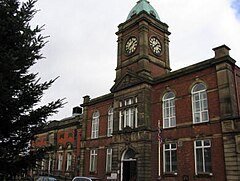Our website is made possible by displaying online advertisements to our visitors.
Please consider supporting us by disabling your ad blocker.
Royton
| Royton | |
|---|---|
 | |
Location within Greater Manchester | |
| Population | 21,284 (2011 Census) |
| OS grid reference | SD919078 |
| • London | 165 mi (266 km) SSE |
| Metropolitan borough | |
| Metropolitan county | |
| Region | |
| Country | England |
| Sovereign state | United Kingdom |
| Post town | OLDHAM |
| Postcode district | OL2 |
| Dialling code | 0161, 01706 |
| Police | Greater Manchester |
| Fire | Greater Manchester |
| Ambulance | North West |
| UK Parliament | |
Royton is a town in the Metropolitan Borough of Oldham, Greater Manchester, England, with a population of 21,284 in 2011.[1][2][3] Close to the source of the River Irk, near undulating land at the foothills of the South Pennines, it is 2 miles (3.2 km) northwest of Oldham, 3 miles (4.8 km) southeast of Rochdale and 8 miles (12.9 km) northeast of Manchester.
Within the boundaries of the historic county of Lancashire, Royton and its surroundings have provided evidence of ancient British, Roman and Viking activity in the area.[4] During the Middle Ages, Royton formed a small township centred on Royton Hall, a manor house owned by a long succession of dignitaries which included the Byrons and Radcliffes. A settlement expanded outwards from the hall which, by as late as 1780, "contained only a few straggling and mean-built cottages".[5] Farming was the main industry of this rural area, with locals supplementing their incomes by hand-loom woollen weaving in the domestic system.
Royton has the distinction of being the first town where a powered cotton mill was built; at Thorp in 1764,[6][7][8] and is one of the first localities in the world to have adopted the factory system. The introduction of textile manufacture during the Industrial Revolution facilitated a process of unplanned urbanisation in the area, and by the mid-19th century Royton had emerged as a mill town. At its zenith, there were 40 cotton mills—some of the largest in the United Kingdom—employing 80% of the local population.[9] Imports of foreign cotton goods began the decline in Royton's textile industry during the mid-20th century, and its last mill closed in 2002.
Today, fewer than a dozen mills are still standing, the majority of which are used for light engineering or as distribution centres.[10] Despite an economic depression brought about by the demise of cotton spinning, Royton's population has continued to grow as a result of intensive housing redevelopment which has modernised its former Edwardian districts.[10]
- ^ "Oldham Ward population/Royton South 2011". Archived from the original on 9 January 2016. Retrieved 6 January 2016.
- ^ "Oldham Ward population?Royton North 2011". Archived from the original on 9 January 2016. Retrieved 6 January 2016.
- ^ Greater Manchester Gazetteer, Greater Manchester County Record Office, Places names – O to R, archived from the original on 18 July 2011, retrieved 17 June 2008
- ^ Stott 1994, p. 5.
- ^ Cite error: The named reference
County of Lancwas invoked but never defined (see the help page). - ^ Oldham Council, Oldham's Economic Profile – Innovation and Technology, oldham.gov.uk, archived from the original on 14 November 2007, retrieved 20 July 2008
- ^ Manchester City Council, Oldham Towns; Royton, spinningtheweb.org.uk, archived from the original on 14 March 2007, retrieved 5 January 2007
- ^ Cite error: The named reference
Visitwas invoked but never defined (see the help page). - ^ Stott 1994, pp. 8–9.
- ^ a b Stott 1994, p. 9.
Previous Page Next Page



